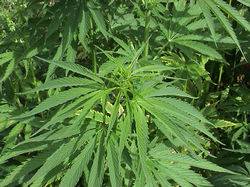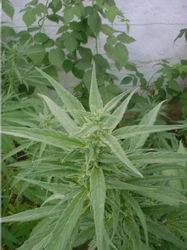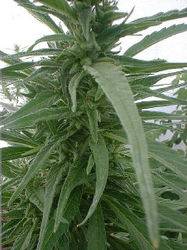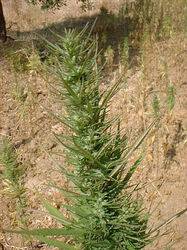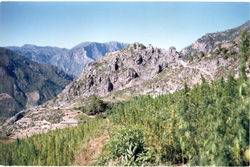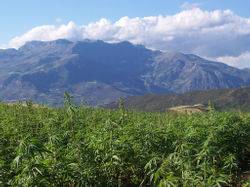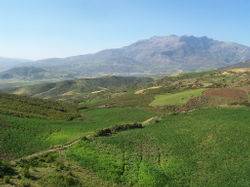You are using an out of date browser. It may not display this or other websites correctly.
You should upgrade or use an alternative browser.
You should upgrade or use an alternative browser.
What is a Landrace?
- Thread starter casey25
- Start date
G
Guest
It could be either most landrace indica strains are in the nothern hemisphere,the landrace sativa's are mainlt equatorial and in the southern hemisphere.The most simple way to descibe a landrace strain is its born of nature,it had and has no human tampering.Finding true landrace strains today might be a big order,us humans have come along and "improved" on them lol
It is estimated that there are between two and twelve different cannabis strains growing wild in countries that have not culled the plant. These wild strains, known as landrace strains, are often cultivated by local residents. The Afghani plant, which has been used by many a cannabis plant breeder to create strains like Kush, Master Kush and the Hash Plant, is a well-known landrace strain.
G
Guest
Thats too cool man.is that really you or did you steal those pics lol.Dont tell me you can actually walk up to one of those..I'll have an envy overdose.
Landrace refers to a race of animals or plants ideally suited for the land (environment) in which they live. they often develop naturally with minimal assistance or guidance from humans (or from humans using traditional rather than modern breeding methods), hence are usually older, less modern races.
...but also important is to know what is an IBL (inbred-line)
every landrace is an IBL but not every IBL is a landrace. for example bubblegum was a hybrid and than inbred till F5 generation ...so it is an IBL... but obviously not a landrace. every landrace is a pure line, so inbred only (never hybridized)
It's also important to know about the ibl because you can get a landrace and than work with it in an other country...so it's not more a landrace but still a pure-line. For example Deep chunk (afghani hashplant) ...this one was a landrace with the origin in Afghanistan ..and later it was heavy-worked in California from TomHill (selections for potency & flavor) ..but only in-line bred, so it's still a pure hashplant afghani.
some DC pix

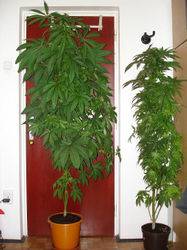

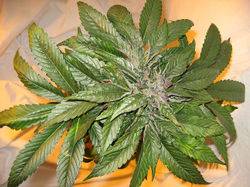


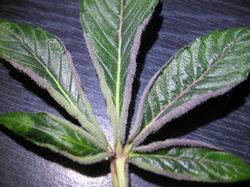

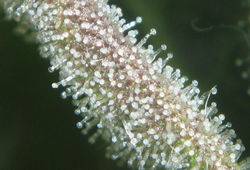
...but also important is to know what is an IBL (inbred-line)
every landrace is an IBL but not every IBL is a landrace. for example bubblegum was a hybrid and than inbred till F5 generation ...so it is an IBL... but obviously not a landrace. every landrace is a pure line, so inbred only (never hybridized)
It's also important to know about the ibl because you can get a landrace and than work with it in an other country...so it's not more a landrace but still a pure-line. For example Deep chunk (afghani hashplant) ...this one was a landrace with the origin in Afghanistan ..and later it was heavy-worked in California from TomHill (selections for potency & flavor) ..but only in-line bred, so it's still a pure hashplant afghani.
some DC pix

G
Guest
Damn XyZ,way to utilize available media in a finite container grow!I thought I grew em big in those plastic walmart specials!
G
Guest
Great info XyZ!!
God, can you imagine just standing downwind of those fields when they are really RIPE? Makes me want to faint!
I wonder how often he has to water those monsters in the Walmart special pots?
Cheers
Obli
God, can you imagine just standing downwind of those fields when they are really RIPE? Makes me want to faint!
I wonder how often he has to water those monsters in the Walmart special pots?
Cheers
Obli
G
Guest
Pure , from Swaziland..!!!..(...the seeds btw....but grown a bit more to the south)




Last edited:
el clandestino
super chato
Mann!!!!! XYZ THOSE PLANTS IS KILLER!!!!!!
sorry but what strain are those bottom pics afgany hashplant, ive never ever seen tric covorage like that its awsome where do i get me one of thoseLandrace refers to a race of animals or plants ideally suited for the land (environment) in which they live. they often develop naturally with minimal assistance or guidance from humans (or from humans using traditional rather than modern breeding methods), hence are usually older, less modern races.
...but also important is to know what is an IBL (inbred-line)
every landrace is an IBL but not every IBL is a landrace. for example bubblegum was a hybrid and than inbred till F5 generation ...so it is an IBL... but obviously not a landrace. every landrace is a pure line, so inbred only (never hybridized)
It's also important to know about the ibl because you can get a landrace and than work with it in an other country...so it's not more a landrace but still a pure-line. For example Deep chunk (afghani hashplant) ...this one was a landrace with the origin in Afghanistan ..and later it was heavy-worked in California from TomHill (selections for potency & flavor) ..but only in-line bred, so it's still a pure hashplant afghani.
some DC pix









What is a Landrace Strain?
What is a Landrace Strain?
Some ideas for discussion....
I think the concept of a landrace strain is a great idea. But how do we really know if a strain is “untouched” and pure? What’s the time frame that a plant must be pure for? How much interaction with the local population is acceptable? Unless we can genetically test all of these strains its next to impossible to call any strain “pure”....
What about cross breeding from tribe to tribe, town to town, country to country but on the same continent? There are sooo few cultures left in the world that are pure how can we expect their weed to be? Especially with the popularity of the internet.
Think about it....
I’d like to come up with a solid definition that explains in detail what a landrace strain is!
What is a Landrace Strain?
Some ideas for discussion....
I think the concept of a landrace strain is a great idea. But how do we really know if a strain is “untouched” and pure? What’s the time frame that a plant must be pure for? How much interaction with the local population is acceptable? Unless we can genetically test all of these strains its next to impossible to call any strain “pure”....
What about cross breeding from tribe to tribe, town to town, country to country but on the same continent? There are sooo few cultures left in the world that are pure how can we expect their weed to be? Especially with the popularity of the internet.
Think about it....
I’d like to come up with a solid definition that explains in detail what a landrace strain is!
I see no one is responding. I don't think anyone really wants to debate and actually that is a good thing. I will post up what I had posted in another thread yesterday:
Societies Definition: Landrace refers to domesticated animals or plants adapted to the natural and cultural environment in which they live (or originated) and, in some cases, work. They often develop naturally with minimal assistance or guidance from humans using traditional breeding methods. Landraces differ somewhat from what is commonly termed a breed, and usually possess more diverse phenotypes and genotypes. They often form the basis of more highly-bred formalised breeds. Sometimes a formalised breed retains the "landrace" name, despite no longer being a true landrace.
My thoughts in regards to Landrace Cannabis: In my thoughts it refers to a strain that is kept and held by Indigenous Peoples within a certain region and kept pure of all outside Cannabis strains and Influences. I feel that Thai, Chile, Himalaya, Afghani and the likes are what true searchers of landraces use as a leveling bar when searching out true landraces. Plants that have not been touched by what we consider modern society, have not been influenced by anyone except for nature and the people indigenous to each specific strains location.
Just my quick thoughts.
Societies Definition: Landrace refers to domesticated animals or plants adapted to the natural and cultural environment in which they live (or originated) and, in some cases, work. They often develop naturally with minimal assistance or guidance from humans using traditional breeding methods. Landraces differ somewhat from what is commonly termed a breed, and usually possess more diverse phenotypes and genotypes. They often form the basis of more highly-bred formalised breeds. Sometimes a formalised breed retains the "landrace" name, despite no longer being a true landrace.
My thoughts in regards to Landrace Cannabis: In my thoughts it refers to a strain that is kept and held by Indigenous Peoples within a certain region and kept pure of all outside Cannabis strains and Influences. I feel that Thai, Chile, Himalaya, Afghani and the likes are what true searchers of landraces use as a leveling bar when searching out true landraces. Plants that have not been touched by what we consider modern society, have not been influenced by anyone except for nature and the people indigenous to each specific strains location.
Just my quick thoughts.
Justa, you make a bunch of excellent questions.
another good question is how do we know the number of parents that initially started a specific landrace population?
these questions are difficult, so there will be little concrete answers, but a lot of speculation.
much peace!
another good question is how do we know the number of parents that initially started a specific landrace population?
these questions are difficult, so there will be little concrete answers, but a lot of speculation.
much peace!
here is a quote i have saved on my computer,,,,,i cant expain it better than this
As we consider the implementation of smart breeding efforts in the future, we might ask, who will have access to nature's reserves of genetic diversity? How will knowledge about the patterns that govern the generation and selective elimination of that diversity help guide conservation efforts as well as current and future crop improvement efforts? What are the limits to biological variation? How far can we push those limits, and what will be the consequences of not pushing them? Who will participate in the endeavor? What will the rules of engagement be? What tools can we use to expedite the effort?
What genetic characteristics will help us cope with climate change, global warming, the emergence of new pests and diseases, depleted soils, shortages of fresh water, and increasing levels of water and air pollution? What trace minerals, vitamins, and other metabolites will we need to breed into the crops of the future to fight the causes of hidden hunger, to prevent cancer, or to enhance the immune system? The combinatorial possibilities for crop improvement are almost infinite, as long as we maintain our options. Faced with a clear choice today, it is obvious that enhancing the potential for genetic flexibility in the future is a wise course of action and one we ignore at our peril.
PubMed said:The landrace varieties are the earliest form of cultivar and represent the first step in the domestication process. Landraces are highly heterogeneous, having been selected for subsistence agricultural environments where low, but stable yields were important and natural environmental fluctuation required a broad genetic base. Landraces are closely related to the wild ancestors and embody a great deal more genetic variation than do modern, high-yielding varieties that are selected for optimal performance within a narrow range of highly managed environmental conditions. The value of both the wild species and the early landrace varieties in the context of modern plant breeding is that they provide a broad representation of the natural variation that is present in the species as a whole. The fact that natural selection has acted on such populations over the course of evolution makes them particularly valuable as materials for breeders. The value added by imposing a low intensity of human selection on the early landraces resides in the fact that some of these early varieties represent accumulations of alleles that produce phenotypes particularly favorable or attractive to the human eye, nose, palette, or other appetites. It is also noteworthy that some of these rare or unique alleles or allele combinations that were selected by humans might never survive in the wild.
Wild relatives and early landrace varieties have long been recognized as the essential pool of genetic variation that will drive the future of plant improvement (Bessey 1906; Burbank 1914). Early plant collections made by people such as Nikolai Vavilov (1887–1943) or Jack Harlan (1917–1998) inspired the international community to establish long-term collections of plant genetic resources that provide modern plant breeders with the material they need to creatively address the challenges of today (Box 1). Many may question the emphasis on wild and primitive landraces that cannot compete with new, high-yielding varieties in terms of productivity or eating quality, particularly in an age when biotechnology and genetic engineering promise to provide an endless stream of genetic novelty. Indeed, if all forms of novelty were equally valuable, the old varieties would hardly be worth saving. But the security of the world's food supply depends on an exquisite balance between new ideas and the intelligent use of time-tested resources. In 1972, more than a decade before the age of automated sequencing, Jack Harlan commented that, “We are not really much interested in conserving the old varieties as varieties; it is the genes we are concerned about. The old land races can be considered as populations of genes and genetic variability is absolutely essential for further improvement. In fact, variability is absolutely essential to even hold onto what we already have” (Harlan 1972a).
Cultivars (domesticated varieties) have been selected by humans in the last 10,000 years and inevitably represent a subset of the variation found in their wild ancestors. Cultivars are recognizable because they manifest characteristics that are associated with domestication in plants. Unusual or extreme phenotypes, such as large fruit or seed size, intense color, sweet flavor, or pleasing aroma are often selected by humans and maintained in their cultivars for aesthetic reasons, while synchronous ripening or inhibition of seed shattering (a dispersal mechanism) are selected to facilitate harvest. These phenotypes may occur in nature but they will frequently be eliminated by natural selection before they are fixed in a population. Because of human selection, cultivars may exemplify a range of exaggerated phenotypic attributes that give them the appearance of being, on the whole, more diverse than some of the wild populations from which they were derived, but in truth, domestication usually represents a kind of genetic bottleneck. Furthermore, cultivars are grown in agricultural environments that are generally more uniform than the environments in which wild species grow, and this tends to further narrow the gene pool. Thus, while cultivars may embody a high degree of obvious phenotypic variation, this may not always be a good predictor of the extent of their genetic variation.
Modern breeds are descendents of the wild species from which they were derived. The process of domestication dramatically changed the performance and genetic architecture of the ancestral species through the process of hybridization and selection as originally described by Charles Darwin (1859).
Despite the low yields and poor eating quality of most wild ancestors and primitive crop varieties, these ancient sources of genetic variation continue to provide the basic building blocks from which all modern varieties are constructed. Breeders have discovered that genes hidden in these low-yielding ancestors can enhance the performance of some of the world's most productive crop varieties. In this essay, I will provide some historical context for the paper by Gur and Zamir in this issue of PLoS Biology (Gur and Zamir 2004). I will discuss how “smart breeding” recycles “old genes” to develop highly productive, stress-resistant modern varieties and why this approach is particularly attractive to increase food security in regions of the world with high concentrations of genetic diversity.
The job of the plant breeder is to create an improved variety. This may be accomplished simply by selecting a superior individual from among a range of existing possibilities, or it may require that a breeder know how to efficiently swap or replace parts, recombine components, and rebuild a biological system that will be capable of growing vigorously and productively in the context of an agricultural environment. How the breeding is done and what goals are achieved is largely a matter of biological feasibility, consumer demand, and production economics. What is clear is that the surest way to succeed in a reasonable amount of time is to have access to a large and diverse pool of genetic variation.
The Pioneers
“Moreover, from our wild plants, we may not only obtain new products but new vigor, new hardiness, new adaptive powers, and endless other desirable new qualities for our cultivated plants. All of these things are as immediate in possibilities and consequences as transcontinental railroads were fifty years ago.”—Luther Burbank, 1914
Luther Burbank (1849–1926) was one of America's first and most prolific plant breeders. He was inspired by Charles Darwin's Variation of Animals and Plants under Domestication (Darwin 1883) to explore the potential of creating new varieties of plants by cross-breeding (hybridization) and selection. Over a 50-year period, he developed more than 800 new varieties of fruits, vegetables, flowers, and grasses. One of his earliest creations was the Burbank potato (1871), a variety of baking potato still popular today. When the Plant Patent Act of 1930 was first introduced in Congress, Thomas Edison testified, “This [bill] will, I feel sure, give us many Burbanks.” The bill passed, and Luther Burbank was awarded 16 posthumous patents for asexually reproduced plants (Burbank 1914).
Nikolai Vavilov (1887–1943), a Russian geneticist and biologist, was one of the first to explore and actively collect wild relatives and early landrace varieties as sources of genetic variation for the future of agriculture. His botanical collecting expeditions (1916–1940) amassed many thousands of rare and valuable specimens that are preserved in the Vavilov Institute of Plant Industry in St. Petersburg, the world's first seed bank and inspiration for the International Crop Germplasm Collections (http://www.sgrp.cgiar.org/publications.html ). Vavilov's concepts in evolutionary genetics, such as the law of homologous series in variation (Vavilov 1922) and the theory of centers of origin of cultivated plants (Vavilov 1926), were major contributions to understanding the distribution of diversity around the world. Vavilov himself died of starvation in a Stalinist prison camp in 1943, victim of a debate about genetics at a time when Trofim Lysenko's theories about the alterability of organisms through directed environmental change proved more compelling to the Soviet leadership than Vavilov's own efforts to demonstrate the genetic value of wild and early landrace diversity.
In the United States, Jack Harlan (1917–1998) was also well known for his plant collection expeditions and eloquent expositions about the value of wild relatives and early domesticated forms of crop plants (Harlan 1972b). What particularly sensitized Jack Harlan to the value of these genetic resources was the fact that he lived through a period of revolutionary change in the way agriculture was practiced, watching as the Green Revolution's high-yielding semi-dwarf varieties of wheat and rice replaced the old landrace varieties throughout Asia and Latin America (Harlan 1975). He understood that the new varieties brought massive and immediate increases in grain production that saved millions from starvation. He also understood that displacement of the traditional varieties from their natural environment presented serious challenges that would require renewed efforts to collect, document, evaluate, and conserve plant genetic resources. “For the sake of future generations, we must collect and study wild and weedy relatives of our cultivated plants as well as the domesticated races. These resources stand between us and catastrophic starvation on a scale we cannot imagine” (Harlan 1972b).
Charlie Rick (1915–2002) was an avid collector of exotic tomato germplasm. He noted that up until the 1940s, progress in tomato improvement lagged and few major innovations were achieved. The turning point, according to Rick, was the introduction of exotic germplasm. As a cultivated species, tomato had experienced a severe genetic bottleneck that led to extreme attrition of genetic variability compared to the wild species of Lycopersicon (Rick and Fobes 1975). Yet, Rick observed that crosses between wild and cultivated species generated a wide array of novel genetic variation in the offspring, despite the fact that routine evaluation of wild and exotic resources often failed to detect the genetic potential of these resources (Rick 1967, 1974). He outlined “pre-breeding” strategies that were designed to uncover positive transgressive variation in backcrossed (inbred) progeny derived from interspecific crosses and believed that this approach would invariably lead to greater utilization of the favorable attributes hidden in tomato exotics (Rick 1983).
As we consider the implementation of smart breeding efforts in the future, we might ask, who will have access to nature's reserves of genetic diversity? How will knowledge about the patterns that govern the generation and selective elimination of that diversity help guide conservation efforts as well as current and future crop improvement efforts? What are the limits to biological variation? How far can we push those limits, and what will be the consequences of not pushing them? Who will participate in the endeavor? What will the rules of engagement be? What tools can we use to expedite the effort?
What genetic characteristics will help us cope with climate change, global warming, the emergence of new pests and diseases, depleted soils, shortages of fresh water, and increasing levels of water and air pollution? What trace minerals, vitamins, and other metabolites will we need to breed into the crops of the future to fight the causes of hidden hunger, to prevent cancer, or to enhance the immune system? The combinatorial possibilities for crop improvement are almost infinite, as long as we maintain our options. Faced with a clear choice today, it is obvious that enhancing the potential for genetic flexibility in the future is a wise course of action and one we ignore at our peril.
justintime420
Active member
i think most quote on quote "landraces" that your buying have landrace genetics or was crossed with landrace strains
I’m a huge fan of the concept of Landrace strains. I think it is needed right now before what is left of them get polluted and wasted.
But....I think the term will lead to a lot of abuse from unscrupulous people in the future. If indeed they become the hottest new thing of the future there are going to be a lot of self proclaimed Kings coming up with all these Landrace strains from god knows where. Ever hear of the little know Inuit strain...the one lost for 200 years and recently rediscovered...it has .9% new genetics and the rest is something something haze and white women with a dead husband....
The problem with this hobby is it has become a billion dollar business and people will do anything for the money....
We need an unbiased institution that can text genetics and report on what’s in these strains. Take a look at what’s going on right now....people are gobbling up strains and just repackaging them under different names...I’m not saying that most people do bad things but 1 out of even a million ruins it for everyone.
Then...you’ve got the issue of unintentional cross breeding in places like Jamaica and Mexico. Try to find a real Jamaican landrace strain these days...! And I hear the drug cartels are mixing top genetics from around the world....
But....I think the term will lead to a lot of abuse from unscrupulous people in the future. If indeed they become the hottest new thing of the future there are going to be a lot of self proclaimed Kings coming up with all these Landrace strains from god knows where. Ever hear of the little know Inuit strain...the one lost for 200 years and recently rediscovered...it has .9% new genetics and the rest is something something haze and white women with a dead husband....
The problem with this hobby is it has become a billion dollar business and people will do anything for the money....
We need an unbiased institution that can text genetics and report on what’s in these strains. Take a look at what’s going on right now....people are gobbling up strains and just repackaging them under different names...I’m not saying that most people do bad things but 1 out of even a million ruins it for everyone.
Then...you’ve got the issue of unintentional cross breeding in places like Jamaica and Mexico. Try to find a real Jamaican landrace strain these days...! And I hear the drug cartels are mixing top genetics from around the world....
here is a quote i have saved on my computer,,,,,i cant expain it better than this
As we consider the implementation of smart breeding efforts in the future, we might ask, who will have access to nature's reserves of genetic diversity? How will knowledge about the patterns that govern the generation and selective elimination of that diversity help guide conservation efforts as well as current and future crop improvement efforts? What are the limits to biological variation? How far can we push those limits, and what will be the consequences of not pushing them? Who will participate in the endeavor? What will the rules of engagement be? What tools can we use to expedite the effort?
What genetic characteristics will help us cope with climate change, global warming, the emergence of new pests and diseases, depleted soils, shortages of fresh water, and increasing levels of water and air pollution? What trace minerals, vitamins, and other metabolites will we need to breed into the crops of the future to fight the causes of hidden hunger, to prevent cancer, or to enhance the immune system? The combinatorial possibilities for crop improvement are almost infinite, as long as we maintain our options. Faced with a clear choice today, it is obvious that enhancing the potential for genetic flexibility in the future is a wise course of action and one we ignore at our peril.
My unfortunate answer to this is....the one that makes the most money....

